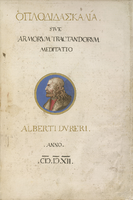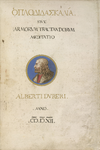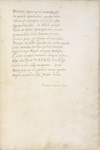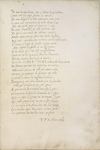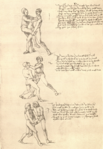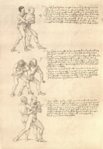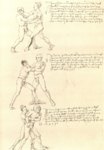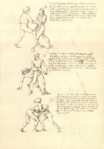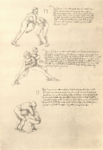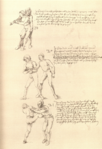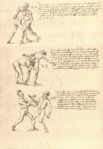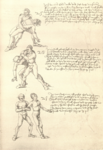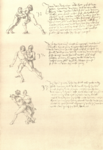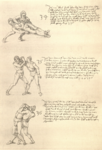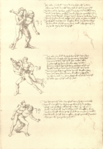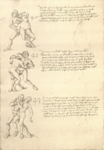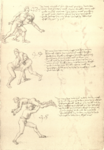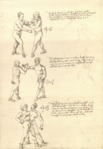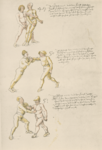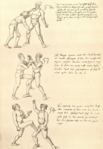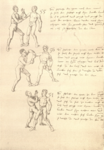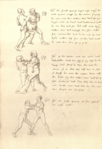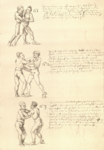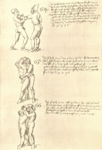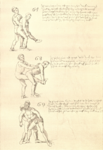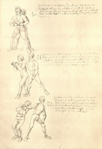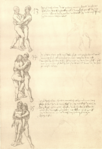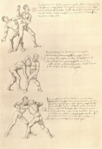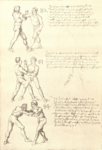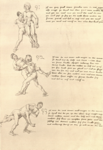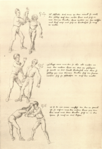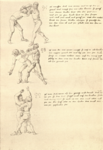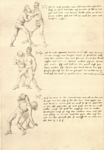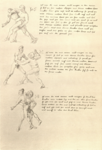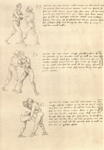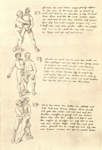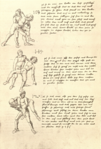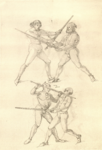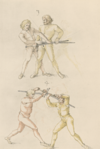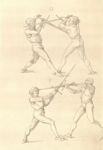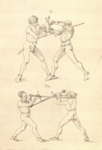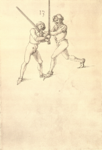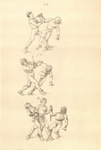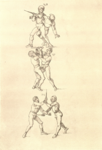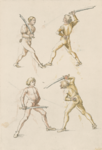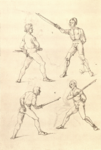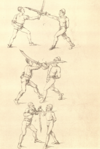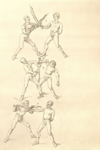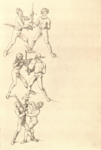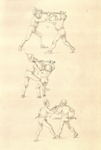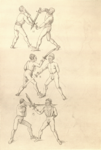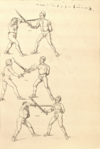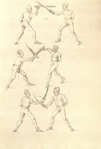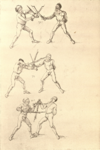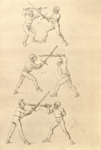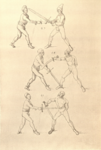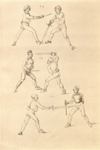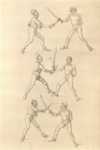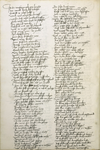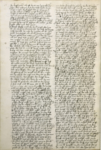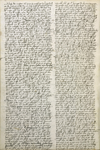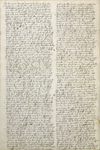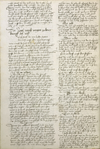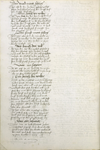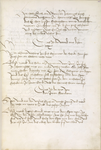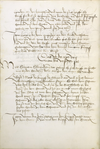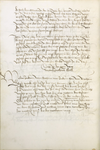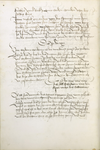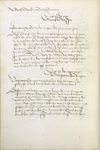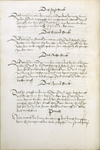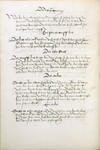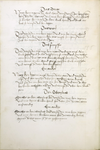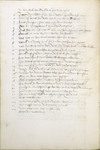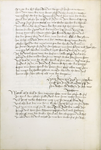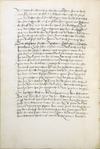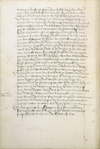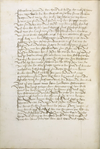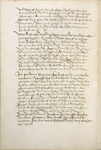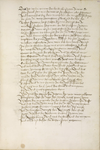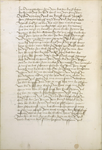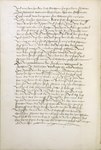No Translation 
|
Transcription [edit]
by Dierk Hagedorn
|
|
|
[112v] Das ist das vechten mit Dem Degenn
Item merck das der vnter Stich Ist der Erst stich Ist der erst stich [!] Im degen vnd hatt neun Stuck mit lerer hand das Erst treib also setz dein linken fus vor vnd hab dein linke hand an der prust wan er Sticht das ver setz Im also Starck von der mit deyner linken handt [113r] auff vnd In der versatzung far vnndenn auff ab vmb
seinen Rechten arm das dein hand kum wider an dein prust
vber sein arm vnd mit der Rechten hand nim In den degen
vnd druck dein elepogenn auch hart an dein Brust
|
|
|
Das ander
Item das versetzt Im Starck also vor vnd far vnden vmb den
arm bis an dein prust vnd mit deyner Rechten hand
greiff hinter seynen rechten elebogenn vnd reiß den Starck
von dir nyder so pricht Im der arm oder muß vallenn
|
|
|
Das Dritt
Das versetz Im Starck als vor vnd mit deyner rechten hand
greiff vnden an seynen knopff vnd leg auch die hand
also mit deinen beiden henden vnd reib die rechten
hand auff dein linck seyttenn
|
|
|
Das vierd stuck
Das versetz Im Starck als vor vnd leg dein Rechte hand auff
dein linke / vnd In der versatzüng So greiff mit deiner rechten
hand an seynenn kn [?] vnd mit deyner linkenn hand far
vmb sein arm als vor So nimstu Im den degenn
|
|
|
Das funfft Stuck
Das versetz Im mit dem kreutz / das Ist mit beyden hennden
oder mit beiden dawmen so halt dein Rechten dawmen
vnd den linken obenn vnd In der versatzunge So halt sein
gerechte hand In deyner gerechten hand vnd mit der linken
hand greiff vnden durch an seynen tegenn an die scheybenn
vnd prich den also kurtz vnd So nimstu Im den degen
|
|
|
[113v] Das setzst Stuck
Das versetz Im mit dem creütz als vor / das der recht daum
vnden sey vnd begreiffs sein rechte hand Starck vnnd
zeuch sy fur dein brust / vnd Stoß In mit deinem linkenn
elpogenn an sein rechten so pricht Im der arm
|
|
|
Das Sibend Stuck
Das versetz Im Starck Im creutze als vor vnd behalt sein
Rechte mit deinen beyden hennden vnd Rucke Im den
vber dein linke achsseln pis an sein elpogenn So pricht
Im der arm
|
|
|
Das Acht Stuck
Das versetz Im also vor mit dem creutz das der linck dawm
vnden sey vnd In der versatzung so behalt sein rechte In
dein linke vnd Stoß die also Starck von dir vnd lauff
Im durch sein rechten arm vnd mit deyner rechten hand
greiff Im vnter die knyepug vnd wurff In vber sein
rechte huff
|
|
|
Das Neund Stuck
Das Ist greifft er dir an die Brust vnd helt dich Starck
vnd Sticht mit dem degen vnden zw so versetz Ime
mit deyner linken hand den Stich Stoß mit deyner
rechten hand sein linck hand von deiner brust In
des far Im vnder seinen hals vnd wurff In vber
das recht knie
|
|
|
Pruch
Nun merck die zwen bruch auff das durch lauffen
denn Erstenn pruch dw Solt greiffen vor seiner prüst [114r] vnnd heb vbersich So Ist Es brochenn Der ander Bruch
auff das durch lassenn [!] vnd wurff dein arm hoch
auff so greifft hinter seinen Ruck In sein linken arm
vnd truck fur dich nyder seinen hals vnd wurff In
So felt er Auff den ars
|
|
|
Sequitur halsstich
Das auch Sticht nach dem hals der versetzt mit der
linkenn hand starck von der brust vnd also bald So
greiff zw mit deinem rechten arm vmb seinen rechten
arm hinter sein elepogenn vnd mit deinem Rechtenn
pein tritt hinter In auff vber dein rechts pein
|
|
|
Ein ander
Sticht er nach dem hals das versetz Im Starck mit der
linkenn hand als vor vnd In der versatzung far Im oben
vber sein rechten arm In dein elpogenn das dein linck
hand kum wider an dein Brust
|
|
|
Der Bruch
Wen dir einer vber dein arm Ist gefallen als oben gesch
ribenn Steett so greiff vber sein achsseln die linck
vnd begreiff den tegenn bey Spitzenn vnd wurff
In vber das linck bein
|
|
|
Der wider Bruch
Wer dir vber die achsseln greifft an den tegenn vnnd
will dich werffen So wart auff den elpogenn vnnd
Stoß den fast von dir So felt er
|
|
|
[114v] Die verfurgunge
Wer dir denn Stich also will versetzenn so schlag den degen zw
dem arm / vnd far vnden durch vnd far Im durch denn
hals mit dem tegenn vnd heb mit deiner linken hand sein
linck pein vnd wurff In
|
|
|
Ein pruch auff das
Der dich also will verfurn vnd will dir vmb den hals farn
So wart auff den Elnpogenn stoß den vbersich vnd nim
Im dar [!] recht pein vnd würff In
|
|
|
Der ober Stich
Der auff dich Sticht den vber sticht so ste mit dem linkenn
fus vor vnd versetz Im Starck von der Brust mit der linkenn
hand vnd mit deinem Rechten arm vall Im In den elpogen
vnd zeuch an dich vnd mit deiner linkenn hand truck
oben von dir so pricht Im der arm
|
|
|
Der ander
Sticht er den obern stich das versetz Im Starck von der Brust
mit der linken hand vnd pleib also In der versatzunge
vnd mit deiner linken hand greiff lanck vber vnder sein
Rechten arm durch bis an dein linke hand / vnd druck Ime
sein linken arm vnd Ruck so pricht Im der arm auch magstu
dein linke hand lassenn farn vnd nim den tegenn auß
dem selbenn Stuck
|
|
|
Ein ander
Sticht er aber obersich als vor versetzt Im mit der linkenn
hand Starck von der Brust als vor vnd mit der versatzung
far vber sein arm das dein linke hand kum wider an
dein Brust so hastu Inn gefangenn
|
|
|
[115r] Ein ander
Sticht er den obersich [!] das versetzt Im mit dem tegenn vnd
mit deim linkenn arm far Inwendig durch sein Rechten
arm so Ist er gefangen
|
|
|
Ein ander
Sticht er denn / obersich [!] vnd hatt dich vor bey der Brust Starck
gefast so Stoß mit deiner Rechten hand sein linke hand Starck
naher vnd far Im [!] des vnder sein hals vnd wurff Inn vber
sein pein
|
|
|
Die verfurünge
Wenn dir einer will versetzenn so Stich Bis/das an die versatzunge
So schlag den degenn an den arm far vnnden durch far
vmb sein hals vnd greiff mit deiner linken hand ann
die Spitzenn vnd truck also nyder
|
|
|
Der pruch
Wen dir einer vmb den hals gefarn Ist vnd hatt sein degen
begriffenn so leg dein rechte hand auff sein linkenn
arm vnd dein linke hand setz vnden an sein Rechten elbogen
vnd heb Starck vbersich vnd mit deiner Rechten druck nyder
So Ist es gebrochenn
|
|
|
Die ander
Sticht er denn vbersich vnd Ist dein Rechter fus vor vnd versetzt
Im mit der rechten hand vnd far mit deinem linken arm
vber sein Rechtenn vnd greiff mit deiner linken hand
an deinen Rechten elobogen so Ist er
|
|
|
Das ander
Versetzt Im mit dem tegenn vnnd mit dem linkenn
arm vnd far vmb sein Rechtenn so Ist er gefangenn
|
|
|
[115v] Das Dritt
Nim dein tegenn In beid hend vnnd versetz Im zwischen
dein Beyden hentten vnd mit dem knopff vnden durch
so kumpt sein tegen In dein linke hand vnd Ruck an
dich so nimstu Im den tegen
|
|
|
Das vierd
Das versetz Im mit dem tegenn vnd mit der linken hand
verkert Ime den tegenn den ortt auff sein prust vnnd
zuck den tegenn vnd Stich Inn
|
|
|
Das funfft
Das versetz Im also mit dem tegenn vnd tritt auff dein
linke seytten vnd In der versatzung so wind vnd sein rechten
arm durch das der ortt kumbt auff sein hertz vnnd
mit deiner linken hand greiff an sein linke achsseln
vnd wurff In vber dein linck pein
|
|
|
Ein ander
Nim den degenn auff deinen Rechten arm vnd versetz Im
also vnd far aussen vber sein rechten arm durch
vnd setz Im an den ortt an sein Brust vnd nim In bey
der linken achsseln als vor vnd wurff In vber dein linck
pein
|
|
|
Den Oberstich
Sticht er den oberstich den versetz Im mit dem tegenn
vnd mit deyner linken hand far vber sein Rechten arm
außwendig
|
|
|
Ein ander
Sticht er den oberstich das versetz Im mit dem tegenn
vnd mit deinem linkenn arm far Inwendig durch
Seynen Rechten arm so Ist er gefangenn
|
|
|
[116r] Die Zwirch Stick habenn vnnd drey bruchenn
Sticht er mit den zwirch stickenn das versetzt Im Starck
mit deinen Rechten hend vnd greiff mit deiner linken
hand an sein Rechten elbogenn vnnd reib Im die arm auff
seinen Ruck vnd las dein linck hand faren vnd greiff hinten
durch sein pein vnd wurff In auff das an gesicht
|
|
|
Der annder
Tutt Im als vor vnd wen der arm dein Ruck Ist so Stoßt
Im sein Rechte hand vber dein linken elnbogenn heb
vbersich so Ist er gepunten vnd gefangen das Ist der vngenant
|
|
|
Der dritt
Versetz Im aber mit deiner rechten hand vnd Stoß mit
der linken linken [!] handt sein arm von dir begreiff sein pein
vnder dem knye heb vbersich so muß er fallen
|
|
|
Das vierd
Eyner der dir will also versetzenn oder werffenn so greiff
mit deyner linken hand vnden an den tegenn vnd Ruck also
fur dich nyder
|
|
|
Ein wider pruch
Wenn dich eyner also begriffenn hatt nim den knopff
mit deiner linken hand vnd Ruck nyder Ein anders So
stos den tegenn auff mit deiner linken hand an den ortt
vnd far Im vmb den hals vnnd Ime tritt fur mit deiner
linkenn hend pein vnd wurff In daruber
|
|
|
Degen Jegen Degenn
Sticht er den vnterstch [!] das versetz Ime mit lerer hand vnd
mit dem degen far vber sein Rechten arm das der degenn [116v] In dein linke hand vnd Ruck fur dich nyder
|
